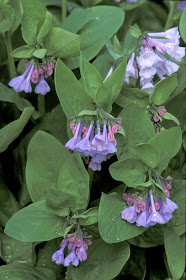Monday, March 31, 2014
Plant of the Week: Virginia Bluebells (Mertensia virginica)
Are you looking for a wildflower that will work under your black walnut tree? Look no further than the showy Virginia Bluebell. It not only tolerates black walnut but also rabbits and deer (partly because it goes dormant so quickly after flowering). This plant is just now coming up in the woods and will be in flower within a week. It prefers alluvial floodplain soils and when found in the right conditions along creeks and rivers in this habitat, it is absolutely abundant and prolific. When planted en masses withe celandine or wood poppies, you can't make a garden any showier. These plants typically get one to two feet tall and the very smooth oval leaves can reach about 7" in length. The individual flowers begin as light pink buds but then turn this beautiful shade of blue, and occasionally pure white, that contrasts with the light green leaves and stems. Given the right growing conditions, this plant will spread and naturalize, sometimes very quickly. It likes sandy to loamy soil and it can be purchased as divisions. Once planted, do not disturb the plants as it can cause them to cease flowering the next year. The primary pollinators for this species are various types of bees although butterflies and hummingbirds have been observed nectaring on them. Good companion plants include wood poppies, large-flowered trillium, and blue phlox although a wide variety of spring flowers work well with this species. This is a species that must be interplanted with ferns or other woodland wildflowers that flower later because it goes dormant so early. Excellent choices include Lady Fern, bugbane or cohosh, and for those into hostas, they work as well. This is certainly a staple of many backyard woodland wildflower or shade gardens and is definitely worthy of a space in yours.


You are absolutely right! This is one of the most beautiful native wildflowers in the world. I have a slew of them in my woodland garden, and it only gets better every year, and it's just about to get better with the suggestion of planting them with Celandine. I think I have a plan now. I'm glad to know about their toleration of black walnut trees and now know just what to plant. Always learning something here.
ReplyDelete